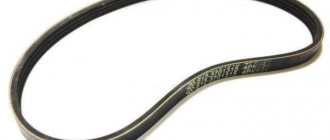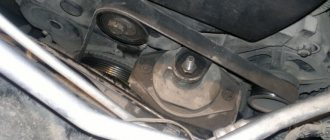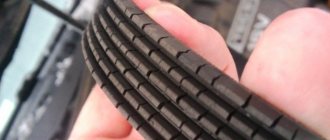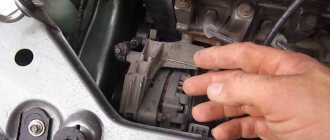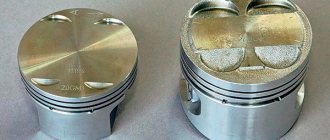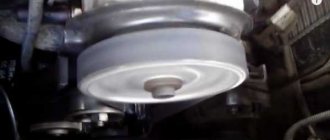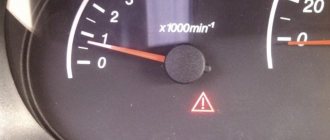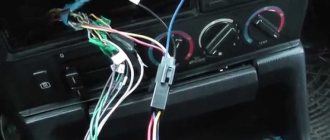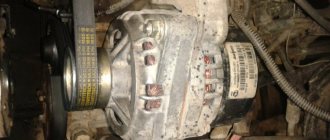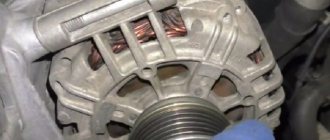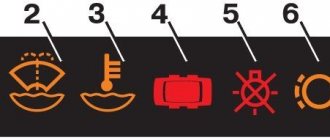Alternator belt device
The whistling of the alternator belt cannot be confused with anything else - this sound, in principle, cannot be confused. Those who want their vehicle to attract the attention of others now need not worry. This is sure to happen with a whistling alternator belt. Of course, this is a joke, then we will try to understand the structure of the element in order to understand how to solve the problem.
The generator is designed to ensure that all vehicle systems stably receive the required level of energy; it is impossible to do without it. A generator device such as a rotor must constantly rotate to generate energy, which is achieved through a belt connection and crank pulley action.
Car alternator belt device
Additional shafts are installed on the device pulley and crankshaft, connected to each other using a ring-shaped strap. Actually, it is from the strap that the rotation is transmitted to the generator. As you understand, the unpleasant sound that often appears when starting the engine in wet weather appears precisely as a result of the operation of this element.
If you open the hood and get to the generator, you can see that the design of the straps can be completely different. However, the principle of their operation and relationship will be identical. As you understand, when the car engine is not running, there can be no sound of any kind; accordingly, it only appears when the parts rub against each other. Thus, it would be quite logical to assume that the shaft slipping occurs as a result of the pulley tensioner being weakened, but we will talk about the reasons further.
Tension problems, belt replacement
Car enthusiasts say that in 90% of cases, the cause of an uncharacteristic whistle is insufficient or excessive belt tension. A special bracket is responsible for the degree of tension, and you can find out the norm for each specific car in the technical passport of the vehicle.
Weak tension on the alternator belt reduces the efficiency of the alternator by an order of magnitude, causing it to not generate the required current. In addition, this is accompanied by rapid wear of the tape. On the other hand, too much tension increases the risk of bearing failure.
To tighten the generator belt, you need to unscrew the nut that connects the generator and the bracket. The bottom nut needs to be loosened a few turns. You can control and change the belt tension by slightly moving the generator away from the cylinder block. After all the manipulations, the nuts are tightened and a check is carried out - before starting the engine, several energy consumers are turned on (headlights or stove). If the work is done correctly, the whistle will disappear.
To replace the belt, you need to repeat the same steps, only you need to move the generating device until the belt is removed from the pulleys. After replacement, you need to let the engine run for a few minutes so that the belt fits correctly.
Reasons why friction occurs and a squeaking sound is made
So, for what reasons does the alternator belt whistle? We will now try to talk about this. According to many motorists, the main reason for the appearance of third-party sounds is wear of the element. However, this is not true in all cases.
As stated above, this is only partly true; we will talk about other reasons further:
- Often the problem with extraneous sounds is that the pulley on which the strap is placed is dirty with some kind of lubricant. This could be either motor oil or any other lubricant that got there accidentally during any repair work. As a rule, this problem occurs not only during startup in wet weather, but at absolutely any time. When the lubricant gets on the element, it ceases to provide normal adhesion functions to the surface of the pulleys. As a result, an unpleasant sound appears.
- Another reason is component sagging. When starting in wet weather this is most noticeable. By the way, this problem is one of the most common, so when it comes to whistling, motorists are always advised to check the tension or condition of the belt.
- If the element is too tight, it will be at its stiffest, which can also lead to noise. If this is the case, then the strap will not be able to transmit sufficient rotation to the pulley, as a result: all elements that rotate with the strap will make a whistling sound. As a rule, car owners encounter such problems in the cold season, because if the strap is hard, then in cold weather it will shrink even more.
- Another reason is bearing wear. If this component is worn out, then the consequence may well be the appearance of third-party sounds when starting the motor, since the bearing itself is part of the drive structure.
- And, of course, the last reason is the wear of the strap itself, which occurs when its service life is exhausted.
Low elasticity, contamination and liquid ingress
For the alternator belt to operate correctly and as efficiently as possible, it must be absolutely clean. The presence of dirt balls puts a lot of stress on the belt when it prevents it from moving evenly and maintaining tension. If during inspection a build-up of dirt and dust was found, you can risk cleaning the tape yourself. Perhaps using gasoline or additional means. If it was not possible to clean the belt, the consumable will have to be replaced.
A similar scheme operates if liquid is detected on the belt. Most often, to continue proper operation, it is enough to remove drops of moisture or technical substances from the surface of the belt.
The opposite situation occurs due to constant or regular exposure to car shampoos, water, detergents and chemicals. Constantly in contact with the polymer structure of the belt, they dry out and contribute to cracking of its surface. To protect the operating process of the car, the alternator belt can be treated with a protective liquid. Its task is to maintain the elastic properties of the material and improve its performance.
It is best to resort to this measure for preventive purposes in order to increase the resource of the element by 1.5–2 times. Such products are produced in the form of an aerosol.
How to deal with this?
Now let's talk about methods to solve the problem. Many vehicle owners are interested in the question - how to eliminate the whistling of the alternator belt in their car, which appears when starting the engine? We will try to explain the essence of the solution to the problem as clearly as possible. Below are methods that will allow you to overcome the problem.
Replacing the strap
To change an element, you need to loosen its tension. In most vehicles, the tension mechanism is adjusted using a bolt or a semicircular adjuster. To begin with, you should study how the component is positioned and what it is hooked onto in order to understand how to remove it. Our resource provides practical instructions for replacing the alternator belt - study them, perhaps you can find something for yourself. It should be noted that the new strap must be installed in exactly the same way as the old one.
Using a wrench, loosen the tension screw until the element can be simply removed. When this happens, remove the strap and replace it with a new one. It is advisable to know how long the new part should be tightened.
Removing dirt
If the strap is too dirty and whistles when starting for this very reason, then the element will also have to be dismantled. Loosen the tension screw and remove the strap. Wipe all sides dry so that there is not even a hint of grease on it. You can use acetone to make it more effective. Also, do not forget to wipe all the pulleys on which the belt is installed; it is quite possible that some of the lubricant got there too.
If there is sagging
This problem is also not particularly difficult to solve. You need to open the hood and check the mechanism. If a component sags even a little, then you need to tighten it; we discussed how to do this above. In addition, pay attention to all the pulleys: they must be located in the same line relative to each other, if this is not the case, then the shafts must be aligned in the right order. Check the technical documentation for the vehicle, it will help you understand this issue.
Sorry, there are no surveys available at this time.
If the strap is too tight
In this case, its position will also need to be adjusted, just not tightened, but loosened. If the starting whistling does not occur in wet weather, but in winter, then this problem usually corrects itself. That is, when the car warms up to the desired temperature, the strap expands slightly, which eliminates the whistling problem.
Bearing replacement
If a part is worn out, then there is only one way out - to replace it with a new one. If everything is fine with the belt itself and there are no signs of deformation on it, then spend time on the secondary components of the system. In this case, you can simply visually diagnose the bearings that affect the operation of the device. There should be no problems with this procedure - a worn part can be easily replaced with a new one by dismantling and installing. We hope that our recommendations will help you solve this problem. And remember - the problem of whistling does not always lie in the belt itself!
Before you begin repair work, it is important to correctly assess your strengths. Before performing the procedures for dismantling and installing the timing belt, it is important to thoroughly familiarize yourself with its structure so that subsequent installation is carried out correctly. If you are not sure of the correctness of your actions, then check the vehicle’s operating manual. At worst, you can always turn to a mechanic at a service station for help.
Belt and its universal functions
Belt drive is the best way to transmit torque to the rotor of a generating device, invented today. This method has been successfully used for many years, differing from other methods in its simplicity. Belt transmission does not require complex and numerous components - two pulleys with shafts connected to each other by an elastic belt are sufficient.
Here the belt itself becomes a universal part, because it has many functions. First of all, the main task is to ensure the rotation of the pulleys.
Note. It is important that the belt is not just elastic and moderately rigid. One part of the element is specially tightened to provide a difference in tension, and, accordingly, to solve the issue of traction force and its efficiency.
Belting
The belt gives transmission to the generator rotor, which must constantly rotate while the car engine is running. The belt in this case ensures not only this, but also the clarity of the transmission, smoothing out the shocks and jerks that inevitably come from the crank shaft.
The belt ensures silent rotation, and high-quality products can simultaneously be moderately rigid and durable, thereby withstanding long-term loads.
Another advantage of the belt is its compactness. It takes up little space while simultaneously performing tasks on a scale disproportionate to its size. The generator, water pump, air conditioning compressor, power steering pump - all of this works thanks to the rotation of the belt.
It is not surprising that after such loads the belt cannot withstand. The disgusting “clanging” emitted by a problematic belt is the very whistle we are writing about. The reason is belt slippage. Sometimes this whistle is so strong that it can be heard at a very long distance.
Ways to fix the problem
To eliminate unpleasant sound, first of all you need to do the following:
:
- checking the correct belt tension;
- cleaning the working surface from dirt;
- visual inspection and assessment of the condition of the belt;
- cleaning the pulley;
- visual inspection of the pulley for damage;
- checking the condition of the mounted bearings.
You can follow part of the recommendation yourself.
. To check bearings and pulley deflections, you can contact a service station. In most cases, these measures are quite sufficient to prevent whistling.
If no faults are found
, the belt continues to whistle, try to restore the elasticity of the product.
It is unacceptable to use petroleum-based fluids for lubrication! There are many spray products on the market, such as Liqui Moly Keilriemen-Spray, Hi-Gear Belt Dressing or Verylub. These products increase the elasticity of the belt, clean working surfaces and protect against moisture.
On a note! If the whistle disappears after using special tools, the belt is most likely to blame.
This is interesting: Pump K80-50-200 - technical characteristics and design
Why does the driver hear a whistle?
When the power unit operates in a car, the belt, along with other drive belts, experiences maximum loads.
Most of the drive belts installed in the machine have a wedge shape, which provides a greater frictional force in the place where the part contacts the pulleys. Such elements even have appropriate names - V-belts.
These same products, but having several paths at once, called streams, are called polywedges.
Generator belts can be with or without teeth. It is generally accepted that products with teeth have a longer service life, since they wear out and slip less often.
So why is there a whistle? In 95% of situations, the manifestation of an unpleasant whistling sound occurs due to the friction of the belt on the pulley if slippage occurs. It turns out that when the belt is unable to turn the pulley, then it slips. This action is accompanied by a sound resembling a whistle.
The motorist should not look for the cause of the sound, but for faults that cause the belt to slip.
There may be several of them:
- Weak and, conversely, very tight tension of the generator belt. Over time, the belt may stretch. The main reason for this is wear and tear of the lower part of the part. The car owner will only need to tighten the connection point. However, it is important to remember not to tighten it too much. In the longest section, the blade should have a stroke in the range of 8 - 10 millimeters. A belt that is too tight can also cause a squealing noise. It is no secret that extremely tight tension does not allow the pulleys to rotate normally. This situation often occurs in winter. The squeak disappears from the moment the engine reaches operating temperature and the belt takes its previous shape.
- Poor quality or temporary wear of the belt. Often, the material used in the production of the belt itself is not the same material applied to the outside of the product from Chinese manufacturers. When the top layer wears, the belt makes a squeaking sound. If the wear is too great, then even the next tension will not help eliminate the problem with the belt whistling. When cracks appear on the product or traces of major destruction can be visually detected, the problem can be corrected by replacement. There is no point in delaying this issue, since such a belt can break at any time.
- Contact with the pulley or belt of technical fluid used in the operation of the machine, for example, oil, washer fluid and even plain water. Problems with whistling appear most often due to contact with engine oil. The belt loses its previous grip and slips with the appearance of a characteristic sound.
- Malfunction of the tension roller or generator bearing. A technical problem with the bearing can cause an unpleasant sound emitted by the hanging belt. The owner of the car will only need to replace the bearing. This structural unit also has special tension rollers. This part is a type of bearing that can begin to seize over time. Because of this problem, the movement of the belt drive is disrupted, the belt rubs heavily against the pulley. In this situation, the belt will show signs of severe wear. The car owner must inspect the mechanism, remove the belt and check the play of the rollers.
- Axle mismatch between pulleys. The appearance of a nasty whistle may be due to misalignment of the line between the two pulleys. The pulleys must be positioned strictly on the same axis, and even a slight slope can cause a whistle.
This is interesting: Preparing the car body for painting
There are several pulleys in a car. The first is located on the crankshaft, and the second on the generator. With constant use of the car, the pulleys wear out. A small pulley is installed on the generator; on the crankshaft, on the contrary, the largest one is installed. Most of the load will go on the small pulley. Some automakers make a small alternator pulley from not the most durable materials. Therefore, wear of the teeth on this part is a matter of time. In addition, situations often occur when damage occurs on the track itself, for example, after an impact.
In any case, the car owner will need diagnostics and replacement of damaged parts.
You will also be interested in:
- How to check the generator voltage regulator
- Signs of a faulty generator diode bridge
- How to check the generator without installing it on the car
